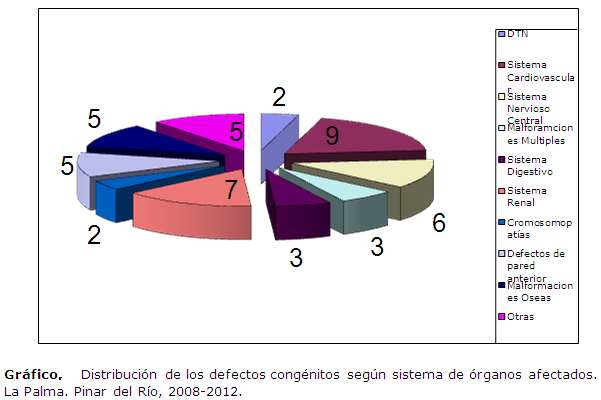Behavior of congenital defects
Keywords:
Congenital abnormalities/diagnosis/genetics, Prenatal diagnosis, Prenatal care.Abstract
Introduction: one of the most important aspects of the national program for diagnosis, management and prevention of genetic diseases and congenital defects is the contribution to maintaining low infant mortality rates, where congenital defects play an important role in the country.Objective: to evaluate the behavior of major congenital defects diagnosed in the prenatal stage, in La Palma Municipality, in the period between 2008 and 2012.
Material and method: a descriptive, retrospective and longitudinal study was performed including a sheer number of pregnant women caught from January 1 2008 to December 31, 2012, in La Palma Municipality.
Results: out of 2043 caught pregnant woman, the 46.5% were classified as increased genetic risk, being this group and the group of ages between 21 and 29 years those with the greater number of congenital defects prenatally diagnosed. Congenital defects of the cardiovascular system occurred most in frequency, followed by renal malformations and of the central nervous system, and out of all of them the higher number decided to finish pregnancy by partnering decision.
Conclusions: Prenatal diagnosis obviously influences on the indicators of morbidity and mortality by congenital defects. Cuban health care network professional are much trained in the services of medical genetics, so the community health services are very effective in this respect.
Downloads
References
1. Delgado Díaz O, Lantigua Cruz A, Cruz Martínez G, Díaz Fuentes C, Berdasquera Corcho D. y Rodríguez Pérez S. Interrupciones de embarazo por malformaciones congénitas. Rev. Cubana Med. Gen Integr[Internet]. abril-junio, 2007[Citado 25 ene 2013]; 23(2): [Aprox. 2 p.]. Disponible en: http://scielo.sld.cu/scielo.php?pid=S0864-21252007000200006&script=sci_arttext
2. Ferrero Oteiza ME, Pérez Mateo MT, Álvarez Fumero R , Rodríguez Peña L. Comportamiento clínico-epidemiológico de los defectos congénitos en la Ciudad de La Habana. Revista Cubana de Pediatría[Internet]. Enero-marzo 2005[Citado 26 feb 2013]; 77(1): [Aprox. 4p.]. Disponible en: http://scielo.sld.cu/scielo.php?pid=S0034-75312005000100002&script=sci_arttext
3. Álvarez Estrabao OA, Ballester Quesada I, Hernández Torres M, Gómez Pérez Y, Cordovez Leyva I. Pesquisaje de defectos congénitos fetales durante la atención prenatal en el área de salud "Manuel Díaz Legra". Correo Científico Médico de Holguín[Internet]. 2009[Citado 20 junio 2013]; 13(3): [Aprox. 5 p.]. Disponible en: http://www.cocmed.sld.cu/no133/no133ori12.htm
4. Martínez de Santelices Cuervo A, Llanos Paneque A. Estudio de la incidencia de las muertes fetales y neonatales por malformaciones congénitas en el municipio 10 de Octubre: 1981-2005. Rev Cubana Genética Comunitaria[Internet]. 2008[Citado 25 ene 2013]; 2(3): [Aprox. 2 p.]. Disponible en: http://www.bvs.sld.cu/revistas/rcgc/v2n3/PDFs%20Infomed/rcgc08308.pdf
5. Donoso Bernales B, Oyarzún Ebensperger E. Embarazo de alto riesgo. Medwave[Internet]. Junio 2012[Citado 20 jun 2013]; 12(5): [Aprox. 6 p.]. Disponible en: http://www.mednet.cl/link.cgi/Medwave/PuestaDia/Practica/5429
6. Figueroa Calderón I, Saavedra Moredo D, De la Torres Sieres Y, Sánchez Lueiro M. Interrupciones de embarazo por causa genética. Rev Cubana Obstet Ginecol[Internet]. oct-dic 2012[Citado 27 jun 2013]; 38(4): [Aprox. 6p.]. Disponible en: http://scielo.sld.cu/scielo.php?script=sci_arttext&pid=S0138-600X2012000400002
7. Garante I, Franco L, López C, Fernández N. Frecuencia de malformaciones congénitas: evaluación y pronóstico de 52.744 nacimientos en tres ciudades colombianas. Biomédica[Internet]. 2010[Citado 28 jun 2013]; 30(65-71): [Aprox.6p.]. Disponible en: http://www.scielo.org.co/pdf/bio/v30n1/v30n1a09.pdf
8. Acosta Batista C, Mullings Pérez R. Malformaciones congénitas en recién nacidos vivos. Municipio Marianao. 2011. Primer Congreso Virtual de Ciencias Morfológicas[Internet] 2012. [Aprox.5p.].Disponible en: http://www.morfovirtual2012.sld.cu/index.php/morfovirtual/2012/paper/viewPaper/316/385 [Citado 28 Jun 2013]
9. Menéndez García R, Licourt Otero D, Cabrera Rodríguez N, Sainz Padrón L. El programa de diagnóstico, manejo y prevención de enfermedades genéticas y defectos congénitos en la provincia Pinar de Río: 1988-2007. Rev. Cubana Genética Comunitaria[Internet]. May-dic 2009[Citado 26 jun 2013]; 3(2-3): [Aprox. 11 p.]. Disponible en: http://bvs.sld.cu/revistas/rcgc/v3n2_3/pinar%20del%20rio.pdf
10. Sera Blanco RA, García Díaz M, Hernández Martínez Y. Exactitud del ultrasonido en el diagnóstico de malformaciones congénitas del segundo trimestre del embarazo. Revista de Ciencias Médicas La Habana[Internet]. 2010[Citado 26 jun 2013]; 16(1). [Aprox. 5 p.] Disponible en: http://revcmhabana.sld.cu/index.php/rcmh/article/view/456/html

Published
How to Cite
Issue
Section
License
Authors who have publications with this journal agree to the following terms: Authors will retain their copyrights and grant the journal the right of first publication of their work, which will be publication of their work, which will be simultaneously subject to the Creative Commons Attribution License (CC-BY-NC 4.0) that allows third parties to share the work as long as its author and first publication in this journal are indicated.
Authors may adopt other non-exclusive license agreements for distribution of the published version of the work (e.g.: deposit it in an institutional telematic archive or publish it in a volume). Likewise, and according to the recommendations of the Medical Sciences Editorial (ECIMED), authors must declare in each article their contribution according to the CRediT taxonomy (contributor roles). This taxonomy includes 14 roles, which can be used to represent the tasks typically performed by contributors in scientific academic production. It should be consulted in monograph) whenever initial publication in this journal is indicated. Authors are allowed and encouraged to disseminate their work through the Internet (e.g., in institutional telematic archives or on their web page) before and during the submission process, which may produce interesting exchanges and increase citations of the published work. (See The effect of open access). https://casrai.org/credit/


